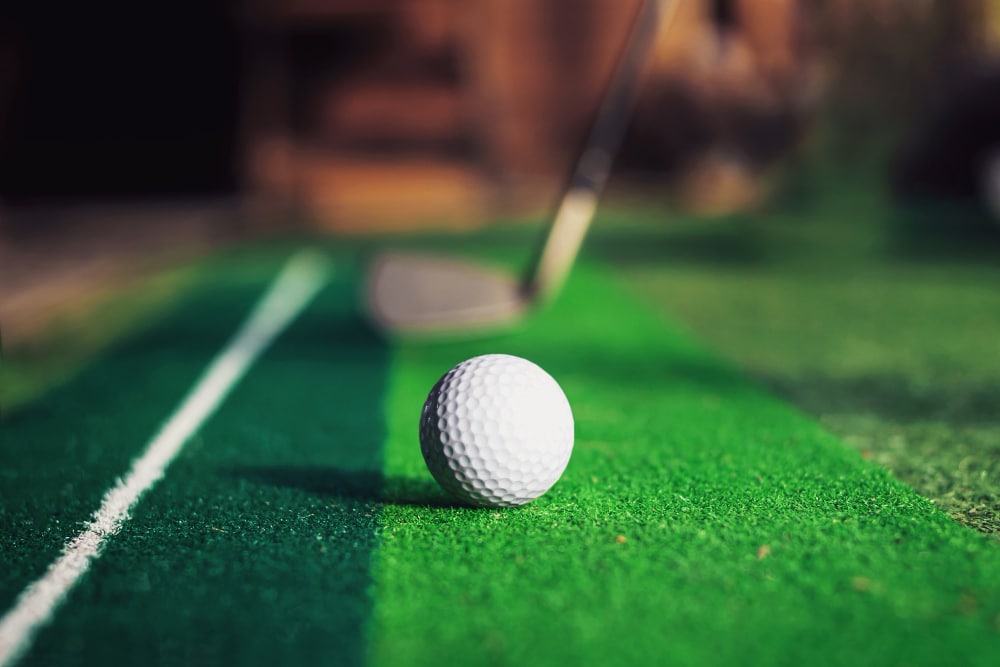Many golfers are opting out to practice their drive, putt and play at home during an off-season. Although it is possible to buy a full array of golf equipment for your backyard, you might not have the financial capability to do that. Besides, there are only limited spaces wherein you can build an 18-hole course even if you have enough money to buy one.

Practice Golf at Home
If this sounds like your problem then don’t worry because there are ways how to practice golf at home that won’t require too much money or too much space. Here are some useful tips:
Find a Good Golf Mat
The first thing you should acquire is a good golf mat. There are many types of mats for practicing your game at home but all of them essentially do the same thing: absorb the impact to lessen its effect on your joints and muscles, thus preventing injuries caused by striking the ground or hard surfaces too often.
You can choose between rubber turf mats, grass mats, turf with rubber backing, etc. depending on your available space and financial constraints. Some of the finest golf hitting mats for home use allow for a long alignment line and multiple cup positions.
With them, you can practice indoors or outdoors with a real surface feel, regardless of grass type (bentgrass, zoysia, Bermuda, etc.). It might be a good idea to consult your local golf shop before you purchase one.
Acquire Driving Net
A driving net is a great way to practice your long drives. Since these nets are pretty much available everywhere, you don’t have to worry about shopping for one.
Just make sure it is made of a durable and sturdy material that won’t break easily when struck by a ball. Some of the best golf nets offer extended targets on either side so you can work on your accuracy as well as distance.
If the net has an automatic rebounder, even better. With this feature, you can just hit the ball without having to chase it across the yard because it will automatically return each time after being struck.
Practice Your Swing with Golf Poles
Golf poles are very practical when practicing your swing at home. You can use them to strengthen important muscles in the lower part of the body.
There are many ways to use golf poles for practice, so don’t be afraid to get creative with this one. For example, if you have an old set of long sticks or even garden stakes lying around then you can shove them into some soft ground and tee up a ball on top of it.
Doing this will help build strength in your legs, hips, and core while ensuring proper balance during impact. If you want something more stable then just place each pole over a fence post with concrete footing on the other side where they won’t fall easily. Just make sure that the posts are in even ground so you can place your feet on solid footing during practice.
Use Chipping Net
People often underestimate the value of chipping practice because it is considered less important than a full swing. However, you can’t neglect this one because it will greatly help your short game and scoring chances. You can make a simple home chipping net using PVC pipe and a large thick net.
You can also use a golf mat covered in artificial turf if you have the space for it. Just set up your chipping net to face a target on the other side of where you’ll be hitting from so you don’t have to drag the ball all over during practice. The net will absorb your shots and allow you to play around with different trajectories each time.
Practice Bunker Shots
If you have a large backyard, then this tip is for you. Try making some bunkers out of the irregular region of your lawn by raking it with flat sides and edges to mimic an actual bunker. Make sure that the ground inside the “bunker” is soft enough so players can dig their feet into it easily during practice.
You also want to make sure that all blades are pointing in one direction just like normal bunkers on golf courses, but be careful not to overdo this because too much can affect drainage or endanger anyone who might run on them while wearing slippery shoes or spikes.
While it is true that having access to a golf course during colder seasons or at night is always preferable, there are some great alternatives that you can use in the meantime. You just need to be resourceful and creative enough to get things done without actually going out on the course physically.
If you can follow these tips and practice them regularly, it will surely improve your game and you will be able to enjoy the sport even more.

